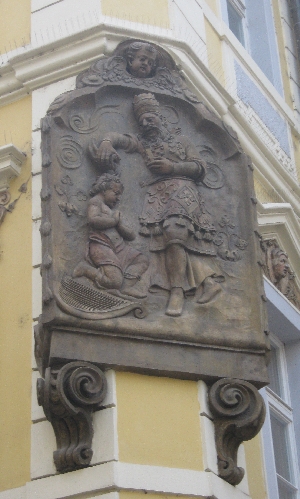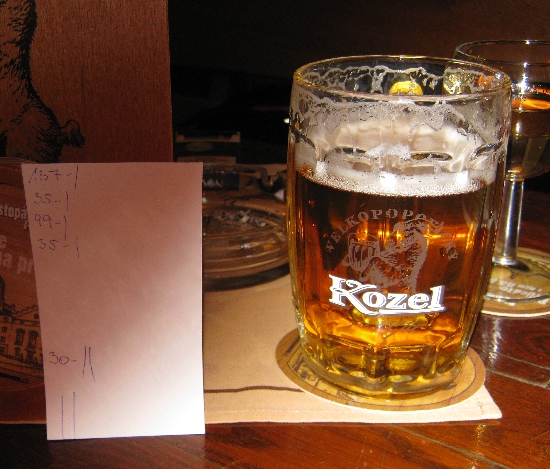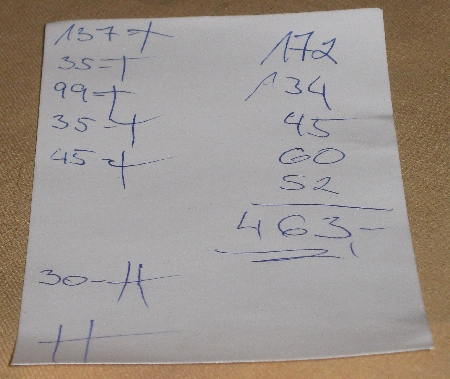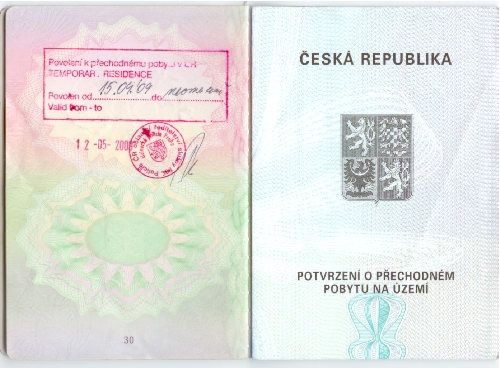
Not all exterior art and sculpture on Prague buildings, as illustrated in my previous post about Prague architecture, is Greco-Roman in style and only featuring semi-naked figures. It is also possible to find many examples of religious art, usually featuring the Virgin Mary and the Infant Jesus, often accompanied by angels. However, the picture on the left shows an artistic relief on the outside of a building which had both Sybille and I mystified for some time as to what it was illustrating.
This relief is on the corner of a building in the heart of Prague which thousands of tourists, as well as city residents, walk past every day. It is in Na Mustku, a street that leads into the bottom of Václavské námestí / Wenceslas Square and adjacent to the major Metro station called Mustek. I think it was about the third time that we stopped and looked up at it that the penny finally dropped – it is an illustration of the Jewish High Priest Samuel, anointing David as King of Israel in succession to Saul.
The Biblical story of how Samuel came to anoint David as the future King of Israel, is to be found in the First Book of Samuel, chapter 16. God tells Samuel that he is sending him to Bethlehem and that he will indicate to him when he gets there, which one of the sons of a man called Jesse, is to be the next king.
Within the story is one of my favourite verses of scripture. Seven sons of Jesse are lined up to pass before Samuel. The eldest son called Eliab, is tall, strong and good-looking and Samuel thinks to himself, ‘Surely this is the one God has chosen’.
‘But the Lord said to Samuel, “Do not consider his appearance or his height, for I have rejected him. The Lord does not look at the things human beings look at. People look at the outward appearance, but the Lord looks at the heart”’ 1 Samuel 16. v7, TNIV
The story continues with the other six sons passing before Samuel but with God indicating to him that none of them either, is the one he has chosen to be King. It is only when David, the youngest son of Jesse, is summoned from the fields where he has been tending the sheep, that God clearly points out that here is the future King and Samuel duly anoints him. Whilst I like the artwork illustrated here, I have to say that the artist has made David look little more than a toddler rather than a young man who can tend his father’s sheep!
It is so easy to make judgments about people purely based upon the way they look. Politicians are forever concerned about having the right image otherwise they fear they won’t get elected. In recent years, there has arisen a group of people who style themselves as ‘Image Consultants’, who will help you look and dress in a manner that they assure you will project the ‘right image’, whatever the ‘right image’ is meant to be. Of course, they will also charge you a substantial fee for doing so!
Sadly, many of us do concentrate purely on someone’s outward appearance, the way they appear, rather than finding out who they are and what motivates them. And much as I try to avoid making instant judgments about people based on the way they dress and look, I know that from time to time, I still do so.
Last summer, a lady walked into our Sunday Eucharist a little after the service had begun. Whilst I know that trying to judge a woman’s age is a dangerous occupation, I thought that she was probably somewhere in her fifties. But along with a fairly conservative blouse, she was wearing suede ankle boots, together with a rather short denim skirt. I have to admit that I immediately assumed her to be a visiting tourist who had stumbled upon an open Church and who would disappear again after five to ten minutes. Because we worship in a city centre Church, we do often get people who wander in at the back during services, because the doors are unlocked, and wander out again a few minutes later.
But this lady didn’t disappear – she stayed for the whole service and came forward and received Communion. And afterwards, she joined us for Coffee Hour in the hall on the third floor of Klimentská 18 across the road from the Church. And so it was that I spoke with her over coffee, asking who she was, where came from, and how had she found us.
The reply was delivered in a fairly broad antipodean accent. She was Dawn, from Ballarat, Victoria in Australia. She was touring Europe but was a regular Churchgoer and therefore had put ‘English-speaking Church, Prague’ into Google on Saturday evening, in order to find Christian worship to attend the following day. She told me how much she had enjoyed the service and her only complaint was that our Church website didn’t explain how to get to the Church by public transport. So, courtesy of Dawn, we have now inserted a link to the Prague Public Transport website as part of our ‘How to find us’ instructions, in order to address the issue that she raised.
Dawn also told me that she was going on to visit Turkey, in order to ‘follow in the footsteps of St. Paul’. And before I could say anything, she acknowledged that she knew full well that she would need to dress differently when travelling in rural Turkey. But today was a warm sunny summer’s day in Prague!
I felt duly rebuked after my conversation with Dawn. I had initially, completely misjudged her, purely based on her appearance. But God hadn’t done that – he saw and knew her motives. He did not look on her outward appearance, but instead, saw and understood the thoughts of her heart.
Dawn – if you should ever read this post, I apologise – especially if I misjudged your age! But also, I ask your forgiveness for initially making a judgement based solely on your outward appearance. After all, why shouldn’t a lady in her fifties wear a denim miniskirt with suede ankle boots, if she has the confidence to do so, especially on a warm summer’s day? And as I’ve said previously many times, when speaking to people at the Church door who are busy apologising to me for what they are wearing when coming to Church, “The Lord doesn’t look on the outside, the Lord looks at the heart”.




















